
Am Fam Physician. 2015;92(5):377-383
POEMs are provided by Essential Evidence Plus, a point-of-care clinical decision support system published by Wiley-Blackwell, Inc. For more information, see http://www.essentialevidenceplus.com.
Author disclosure: Dr. Ebell is cofounder and editor-in-chief of Essential Evidence Plus, published by Wiley-Blackwell, Inc. Dr. Grad has no relevant financial affiliations. See Editor's Note.
A team of primary care clinicians with expertise in evidence-based medicine performed monthly surveillance of more than 110 English-language clinical research journals during 2014, and identified 255 studies that had the potential to change how family physicians practice. Each study was critically appraised and summarized, focusing on its relevance to primary care practice, validity, and likelihood that it could change practice. A validated tool was used to obtain feedback from members of the Canadian Medical Association about the clinical relevance of each POEM (patient-oriented evidence that matters) and the benefits they expect for their practice. This article, the fourth installment in this annual series, summarizes the 20 POEMs based on original research studies judged to have the greatest impact on practice for family physicians. Key studies for this year include advice on symptomatic management and prognosis for acute respiratory infections; a novel and effective strengthening treatment for plantar fasciitis; a study showing that varenicline plus nicotine replacement is more effective than varenicline alone; a network meta-analysis concluding that angiotensin-converting enzyme inhibitors are preferred over angiotensin II receptor blockers; the clear benefits of initial therapy with metformin over other agents in patients with diabetes mellitus; and important guidance on the use of anticoagulants.
For more than 20 years, a group of clinicians with expertise in primary care and evidence-based practice have performed monthly surveillance of more than 110 English-language research journals.1 Of more than 20,000 research studies published in these journals during 2014, 255 met our criteria for validity, relevance, and practice change. We considered a study to be valid if it avoided important biases such as failure to conceal allocation or failure to mask outcome assessment. Relevance is defined as a study that reports patient-oriented outcomes, such as morbidity, mortality, or quality of life. We also prioritize studies that would change practice over those that merely confirm existing practice (that is, they “matter”). Studies that meet these criteria are called POEMs, or patient-oriented evidence that matters.2
Since 2005, the Canadian Medical Association (CMA) has sponsored a subscription to POEMs for all of its members. Each member has the option to receive the daily POEM by e-mail. When members read the POEM, they can also rate it with a validated tool called the Information Assessment Method (IAM). The IAM tool addresses relevance to clinicians, cognitive impact, use in practice, and expected health benefits if the results of the POEM are applied.3 For this article, we identified the 20 POEMs that were rated highest for clinical relevance by CMA members for 2014. Each POEM was rated by at least 500 physicians. At least 70% of respondents rated each of these POEMs as “totally relevant for at least one of your patients,” whereas less than 15% rated each as “not relevant for at least one of your patients.”
Respiratory Disease
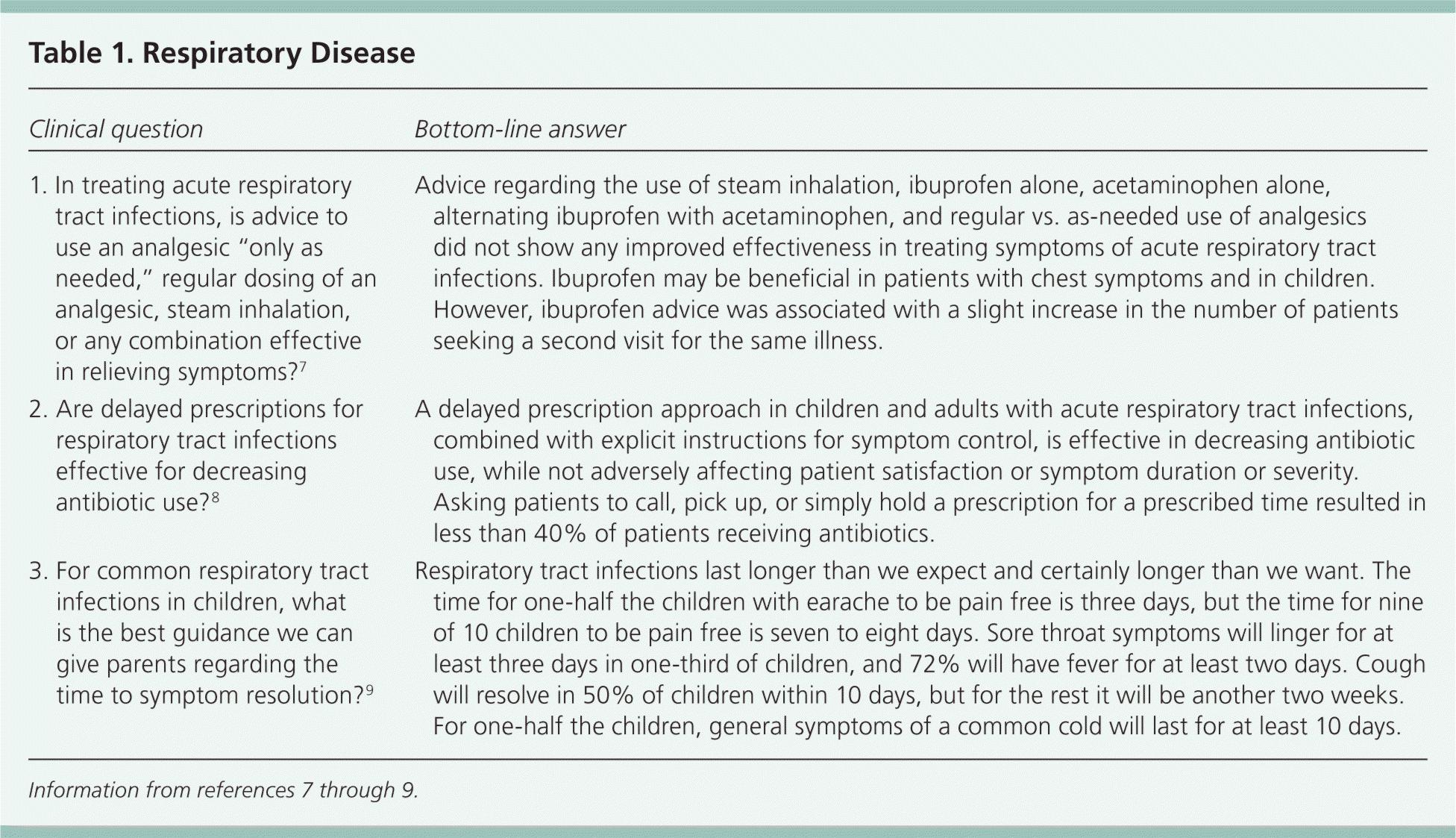
| Clinical question | Bottom-line answer |
|---|---|
| 1. In treating acute respiratory tract infections, is advice to use an analgesic “only as needed,” regular dosing of an analgesic, steam inhalation, or any combination effective in relieving symptoms?7 | Advice regarding the use of steam inhalation, ibuprofen alone, acetaminophen alone, alternating ibuprofen with acetaminophen, and regular vs. as-needed use of analgesics did not show any improved effectiveness in treating symptoms of acute respiratory tract infections. Ibuprofen may be beneficial in patients with chest symptoms and in children. However, ibuprofen advice was associated with a slight increase in the number of patients seeking a second visit for the same illness. |
| 2. Are delayed prescriptions for respiratory tract infections effective for decreasing antibiotic use?8 | A delayed prescription approach in children and adults with acute respiratory tract infections, combined with explicit instructions for symptom control, is effective in decreasing antibiotic use, while not adversely affecting patient satisfaction or symptom duration or severity. Asking patients to call, pick up, or simply hold a prescription for a prescribed time resulted in less than 40% of patients receiving antibiotics. |
| 3. For common respiratory tract infections in children, what is the best guidance we can give parents regarding the time to symptom resolution?9 | Respiratory tract infections last longer than we expect and certainly longer than we want. The time for one-half the children with earache to be pain free is three days, but the time for nine of 10 children to be pain free is seven to eight days. Sore throat symptoms will linger for at least three days in one-third of children, and 72% will have fever for at least two days. Cough will resolve in 50% of children within 10 days, but for the rest it will be another two weeks. For one-half the children, general symptoms of a common cold will last for at least 10 days. |
Respiratory tract infections remain one of the most common reasons for a visit to a family physician, so these three POEMs are particularly relevant (Table 17–9 ). Studies 1 and 2 come from a group of British primary care physician researchers. The first study randomized patients older than three years to several different kinds of advice on symptomatic treatment for acute respiratory tract infection. Patients with a chest infection did a little better with ibuprofen, as did children, but otherwise the type of advice given had little impact on recovery.7 This can be interpreted two ways: nothing works, or it all works equally well. The second study included children and adults, and randomized them to no prescription, to receive a prescription at that visit, or to one of three delayed-prescribing strategies (i.e., patients were asked to recontact the physician for a prescription, given a postdated prescription, or able to collect a prescription at the reception desk if needed).8 Only 40% of patients with a delayed prescription eventually filled it, and outcomes were similar between groups (and with those who were given a prescription). Although the best way to reduce inappropriate antibiotic use is to not prescribe them for acute bronchitis and other largely viral infections, delayed prescriptions are a good alternative when patients are insistent.
Study 3 was a systematic review of the duration of common respiratory tract infections in children.9 The authors found that regardless of the treatment chosen, many children are symptomatic for one week or longer. Counseling parents to be patient, setting realistic expectations, and remembering to provide advice on symptomatic therapy may help reduce demand for antibiotics.
Musculoskeletal Disease
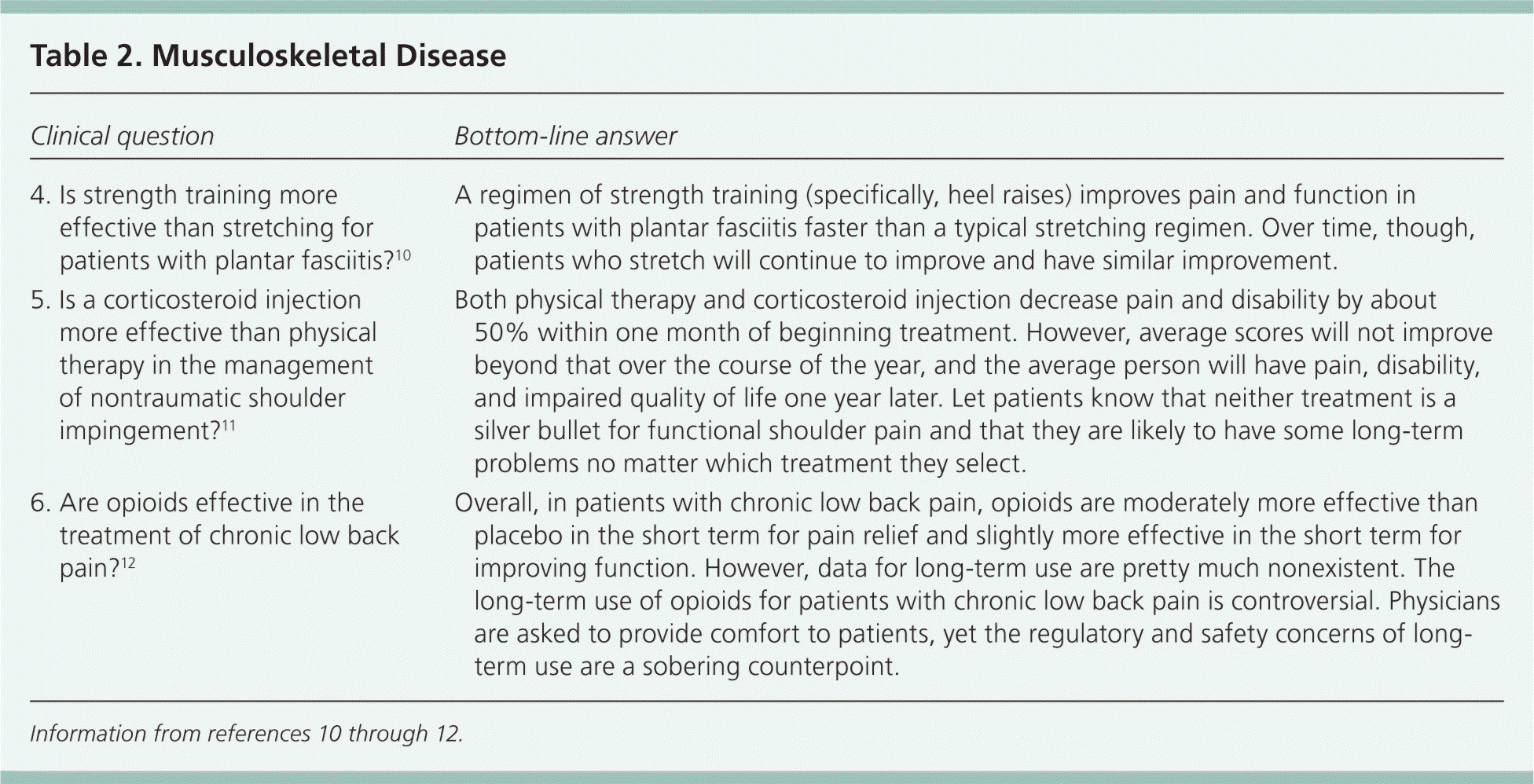
| Clinical question | Bottom-line answer |
|---|---|
| 4. Is strength training more effective than stretching for patients with plantar fasciitis?10 | A regimen of strength training (specifically, heel raises) improves pain and function in patients with plantar fasciitis faster than a typical stretching regimen. Over time, though, patients who stretch will continue to improve and have similar improvement. |
| 5. Is a corticosteroid injection more effective than physical therapy in the management of nontraumatic shoulder impingement?11 | Both physical therapy and corticosteroid injection decrease pain and disability by about 50% within one month of beginning treatment. However, average scores will not improve beyond that over the course of the year, and the average person will have pain, disability, and impaired quality of life one year later. Let patients know that neither treatment is a silver bullet for functional shoulder pain and that they are likely to have some long-term problems no matter which treatment they select. |
| 6. Are opioids effective in the treatment of chronic low back pain?12 | Overall, in patients with chronic low back pain, opioids are moderately more effective than placebo in the short term for pain relief and slightly more effective in the short term for improving function. However, data for long-term use are pretty much nonexistent. The long-term use of opioids for patients with chronic low back pain is controversial. Physicians are asked to provide comfort to patients, yet the regulatory and safety concerns of long-term use are a sobering counterpoint. |
Plantar fasciitis is common and can be frustrating to treat, with most patients taking months to recover. Study 4 (Table 210–12 ) reports the results of a randomized controlled trial comparing the stretching regimen that represents the standard of care with a clever strengthening program that uses towels, steps, and a backpack full of books. The strengthening program helped patients recover much more quickly than the stretching regimen.10
What should we do for patients with nontraumatic shoulder pain, often called shoulder impingement syndrome? Study 5 found that physical therapy and corticosteroid injections were equally effective, so patient preference should be an important factor.11 In study 6, the final high-impact musculoskeletal POEM, a systematic review from the Cochrane Collaboration looked at the use of opioids for chronic low back pain. The authors found few long-term studies, and only modest evidence of benefit in the short term for pain and function.12
Lifestyle Changes
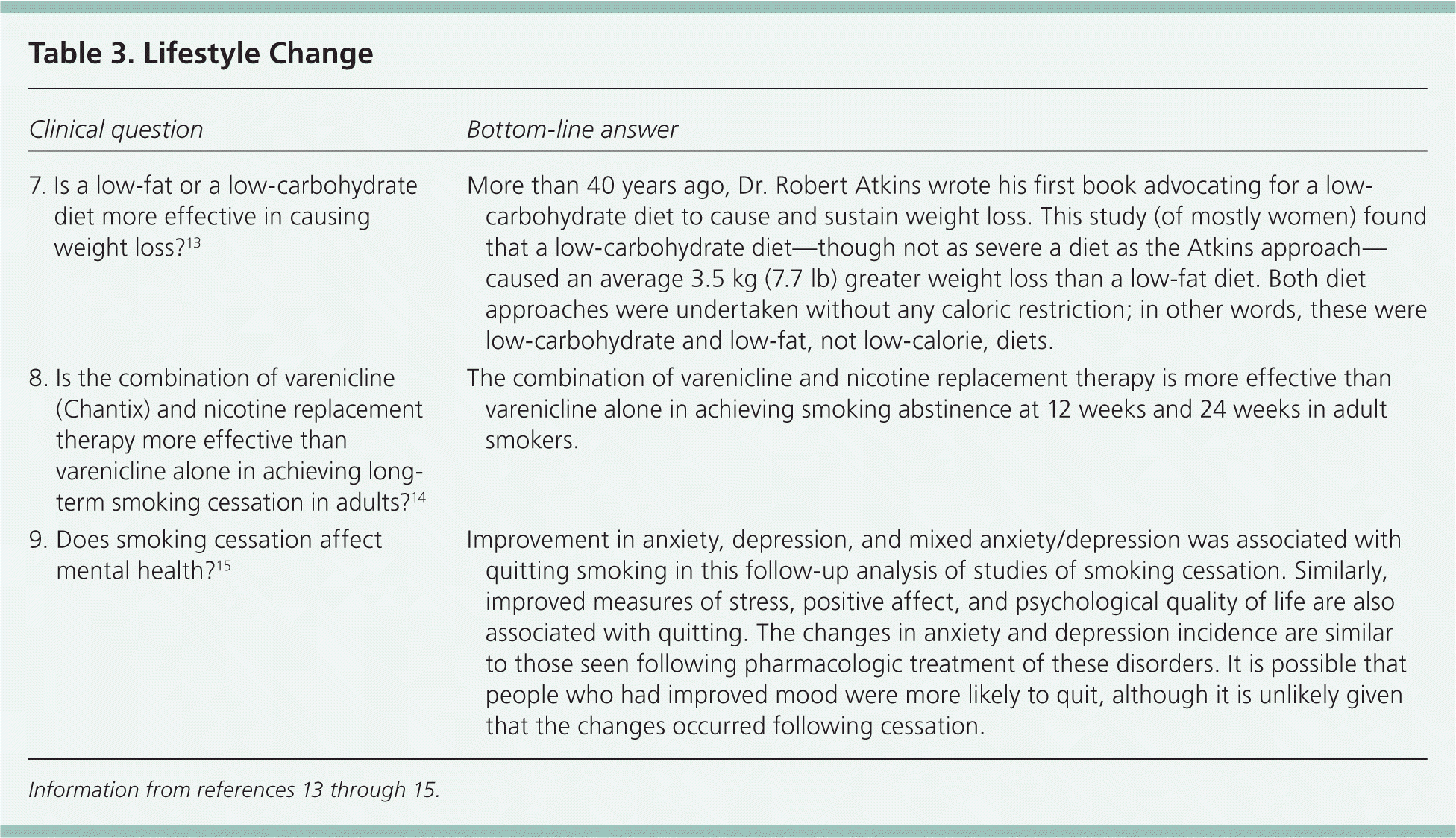
| Clinical question | Bottom-line answer |
|---|---|
| 7. Is a low-fat or a low-carbohydrate diet more effective in causing weight loss?13 | More than 40 years ago, Dr. Robert Atkins wrote his first book advocating for a low-carbohydrate diet to cause and sustain weight loss. This study (of mostly women) found that a low-carbohydrate diet—though not as severe a diet as the Atkins approach—caused an average 3.5 kg (7.7 lb) greater weight loss than a low-fat diet. Both diet approaches were undertaken without any caloric restriction; in other words, these were low-carbohydrate and low-fat, not low-calorie, diets. |
| 8. Is the combination of varenicline (Chantix) and nicotine replacement therapy more effective than varenicline alone in achieving long-term smoking cessation in adults?14 | The combination of varenicline and nicotine replacement therapy is more effective than varenicline alone in achieving smoking abstinence at 12 weeks and 24 weeks in adult smokers. |
| 9. Does smoking cessation affect mental health?15 | Improvement in anxiety, depression, and mixed anxiety/depression was associated with quitting smoking in this follow-up analysis of studies of smoking cessation. Similarly, improved measures of stress, positive affect, and psychological quality of life are also associated with quitting. The changes in anxiety and depression incidence are similar to those seen following pharmacologic treatment of these disorders. It is possible that people who had improved mood were more likely to quit, although it is unlikely given that the changes occurred following cessation. |
Helping achieve lifestyle change is one of the most important things we can do for patients and also one of the hardest. Study 7 (Table 313–15 ) was a clinical trial with 148 participants, of whom 88% were women and one-half were black, who were randomized to a low-carbohydrate diet (less than 40 g per day) or a low-fat diet (less than 30% of calories from fat). After one year, the low-carbohydrate group had lost 5.3 kg (11.7 lb) compared with only 1.8 kg (4.0 lb) for the low-fat group.13
Studies 8 and 9 addressed smoking cessation, with the first asking whether the combination of varenicline (Chantix) plus nicotine replacement was more effective than varenicline alone. The randomized controlled trial with 446 participants who smoked at least half a pack per day during the previous year found that at 24 weeks, quit rates were significantly higher with the combination therapy (65% vs. 47%; number needed to treat = 6; 95% confidence interval, 4 to 11).14 Finally, a meta-analysis reviewed the literature on the psychological effects of quitting smoking, and found that those who quit generally had greater improvements in anxiety, depression, stress, and quality of life than those who continued smoking.15
Diabetes Mellitus
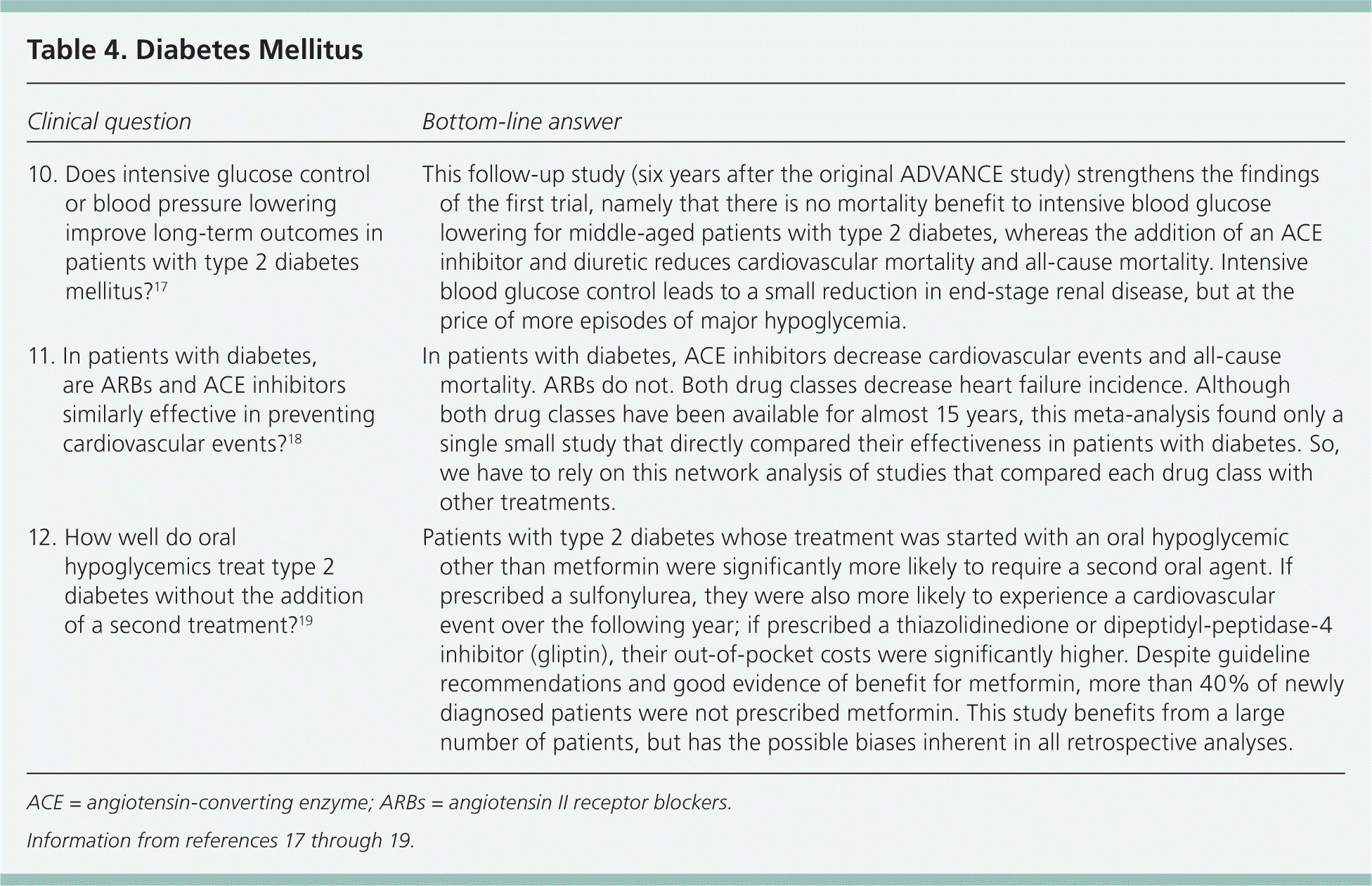
| Clinical question | Bottom-line answer |
|---|---|
| 10. Does intensive glucose control or blood pressure lowering improve long-term outcomes in patients with type 2 diabetes mellitus?17 | This follow-up study (six years after the original ADVANCE study) strengthens the findings of the first trial, namely that there is no mortality benefit to intensive blood glucose lowering for middle-aged patients with type 2 diabetes, whereas the addition of an ACE inhibitor and diuretic reduces cardiovascular mortality and all-cause mortality. Intensive blood glucose control leads to a small reduction in end-stage renal disease, but at the price of more episodes of major hypoglycemia. |
| 11. In patients with diabetes, are ARBs and ACE inhibitors similarly effective in preventing cardiovascular events?18 | In patients with diabetes, ACE inhibitors decrease cardiovascular events and all-cause mortality. ARBs do not. Both drug classes decrease heart failure incidence. Although both drug classes have been available for almost 15 years, this meta-analysis found only a single small study that directly compared their effectiveness in patients with diabetes. So, we have to rely on this network analysis of studies that compared each drug class with other treatments. |
| 12. How well do oral hypoglycemics treat type 2 diabetes without the addition of a second treatment?19 | Patients with type 2 diabetes whose treatment was started with an oral hypoglycemic other than metformin were significantly more likely to require a second oral agent. If prescribed a sulfonylurea, they were also more likely to experience a cardiovascular event over the following year; if prescribed a thiazolidinedione or dipeptidyl-peptidase-4 inhibitor (gliptin), their out-of-pocket costs were significantly higher. Despite guideline recommendations and good evidence of benefit for metformin, more than 40% of newly diagnosed patients were not prescribed metformin. This study benefits from a large number of patients, but has the possible biases inherent in all retrospective analyses. |
The original ADVANCE study found no benefit to intensive blood glucose control, with an A1C target of 6.5%, compared with a target of 7.5%.16 Study 10 (Table 417–19 ) adds another six years of follow-up post-randomization, and found a benefit of blood pressure control but not of more intensive glucose control.17 Blood pressure control in patients with diabetes mellitus was also the topic of study 11, which was a network meta-analysis comparing the benefits of angiotensin-converting enzyme (ACE) inhibitors and angiotensin II receptor blockers (ARBs). The authors found 23 studies of ACE inhibitors, 13 studies of ARBs, and a single small trial that directly compared the two drug classes. Based on indirect comparisons (which is what a network meta-analysis does), the authors found that ACE inhibitors significantly reduced all-cause mortality, cardiovascular events, and heart failure, whereas ARBs reduced only the incidence of heart failure.18 ACE inhibitors should be the drug of choice for patients with diabetes, unless contraindicated.
Finally, study 12 followed patients who had been prescribed a single oral hypoglycemic medication, and found that only 57% had been given metformin as the initial oral agent for the treatment of type 2 diabetes.19 This is disappointing, because it is the only oral agent shown to improve mortality. Patients given metformin were less likely to be given a second agent (25% vs. 37%). Perhaps this is because metformin has a greater hypoglycemic effect. Alternatively, perhaps the evidence-based physicians who prescribed metformin first also knew that overly aggressive glycemic targets are not indicated; therefore, they were less likely to prescribe a second agent. Confirming findings from previous studies, patients started on a sulfonylurea were more likely to eventually need insulin, and were more likely to have a cardiovascular event.
Cardiovascular Disease
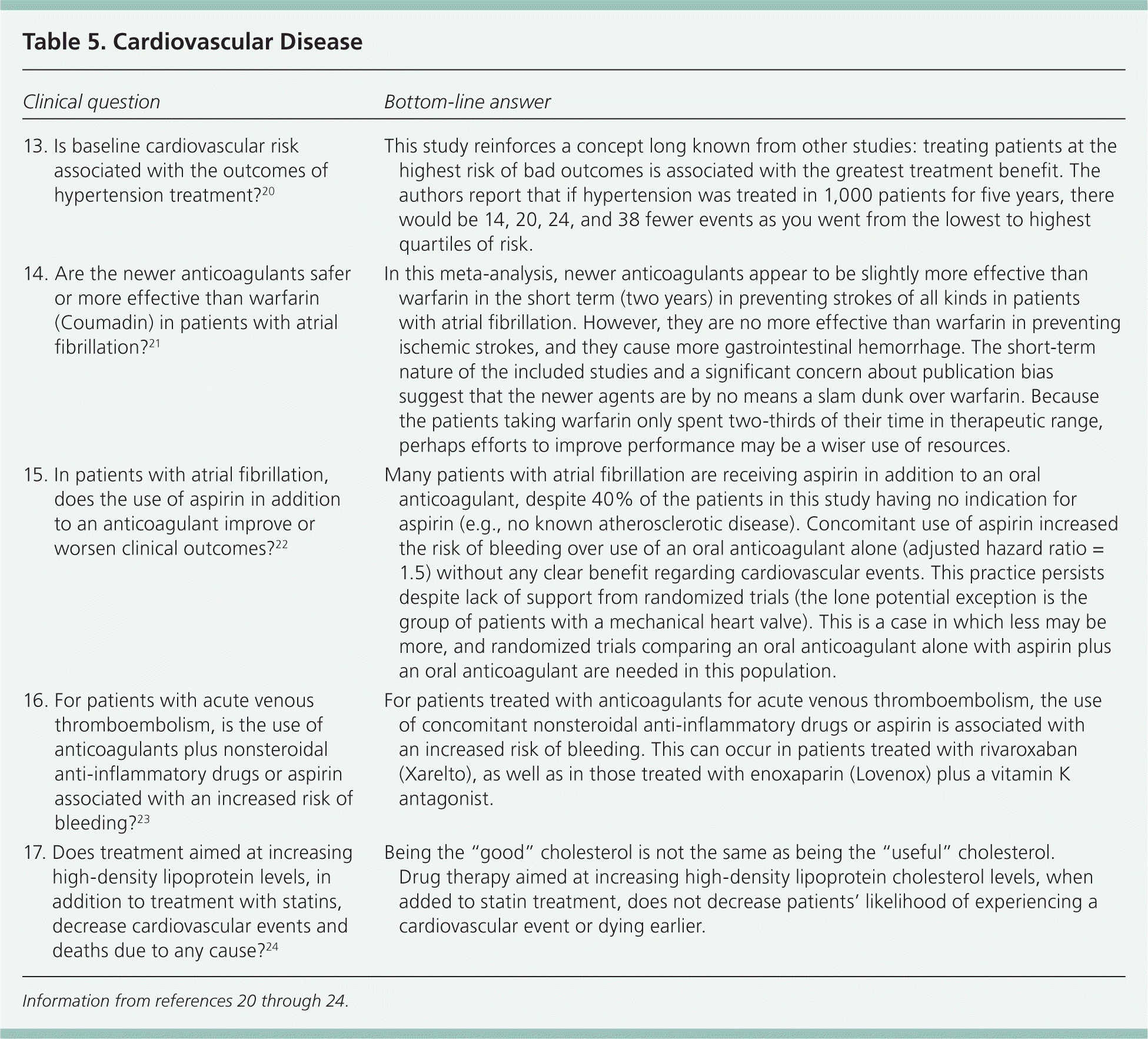
| Clinical question | Bottom-line answer |
|---|---|
| 13. Is baseline cardiovascular risk associated with the outcomes of hypertension treatment?20 | This study reinforces a concept long known from other studies: treating patients at the highest risk of bad outcomes is associated with the greatest treatment benefit. The authors report that if hypertension was treated in 1,000 patients for five years, there would be 14, 20, 24, and 38 fewer events as you went from the lowest to highest quartiles of risk. |
| 14. Are the newer anticoagulants safer or more effective than warfarin (Coumadin) in patients with atrial fibrillation?21 | In this meta-analysis, newer anticoagulants appear to be slightly more effective than warfarin in the short term (two years) in preventing strokes of all kinds in patients with atrial fibrillation. However, they are no more effective than warfarin in preventing ischemic strokes, and they cause more gastrointestinal hemorrhage. The short-term nature of the included studies and a significant concern about publication bias suggest that the newer agents are by no means a slam dunk over warfarin. Because the patients taking warfarin only spent two-thirds of their time in therapeutic range, perhaps efforts to improve performance may be a wiser use of resources. |
| 15. In patients with atrial fibrillation, does the use of aspirin in addition to an anticoagulant improve or worsen clinical outcomes?22 | Many patients with atrial fibrillation are receiving aspirin in addition to an oral anticoagulant, despite 40% of the patients in this study having no indication for aspirin (e.g., no known atherosclerotic disease). Concomitant use of aspirin increased the risk of bleeding over use of an oral anticoagulant alone (adjusted hazard ratio = 1.5) without any clear benefit regarding cardiovascular events. This practice persists despite lack of support from randomized trials (the lone potential exception is the group of patients with a mechanical heart valve). This is a case in which less may be more, and randomized trials comparing an oral anticoagulant alone with aspirin plus an oral anticoagulant are needed in this population. |
| 16. For patients with acute venous thromboembolism, is the use of anticoagulants plus nonsteroidal anti-inflammatory drugs or aspirin associated with an increased risk of bleeding?23 | For patients treated with anticoagulants for acute venous thromboembolism, the use of concomitant nonsteroidal anti-inflammatory drugs or aspirin is associated with an increased risk of bleeding. This can occur in patients treated with rivaroxaban (Xarelto), as well as in those treated with enoxaparin (Lovenox) plus a vitamin K antagonist. |
| 17. Does treatment aimed at increasing high-density lipoprotein levels, in addition to treatment with statins, decrease cardiovascular events and deaths due to any cause?24 | Being the “good” cholesterol is not the same as being the “useful” cholesterol. Drug therapy aimed at increasing high-density lipoprotein cholesterol levels, when added to statin treatment, does not decrease patients' likelihood of experiencing a cardiovascular event or dying earlier. |
This category had the largest number of high-impact POEMs in 2014 with five (Table 5).20–24 Study 13 pooled data at the individual patient level from 11 randomized trials with 52,000 participants, and divided them into four risk groups for cardiovascular events, from less than 11% to more than 21%.20 The relative reduction in risk with treatment of hypertension was similar in each group, but the absolute reduction was higher in higher-risk groups. Reducing a large risk by 15% leads to greater absolute benefit than cutting a small risk by the same amount. Study 14 is a meta-analysis comparing novel oral anticoagulants with warfarin (Coumadin), and it found that there are advantages and disadvantages to these agents.21
The next two POEMs addressed the question of whether it is safe to administer aspirin or nonsteroidal anti-inflammatory drugs (NSAIDs) in patients who are receiving an anticoagulant. Study 15 used data from a large registry of patients with nonvalvular atrial fibrillation, and found a significantly increased risk of bleeding in those receiving aspirin plus an anticoagulant, but no benefit in terms of fewer cardiovascular events.22 Study 16 looked at patients with acute venous thromboembolism who were also receiving aspirin or an NSAID, and similarly found a significant increase in the likelihood of major bleeding, especially with NSAIDs.23
Finally, study 17 was another meta-analysis. This one asked whether interventions to raise high-density lipoprotein cholesterol levels actually improved patient-oriented outcomes. The answer, unfortunately, is no. The authors found 11 studies of niacin, 20 studies of fibrates, and eight studies of other drugs, with a total of more than 100,000 participants. Although these drugs increased high-density lipoprotein cholesterol levels, they had no effect on all-cause mortality, cardiovascular mortality, or the risk of stroke.24
Cancer Screening
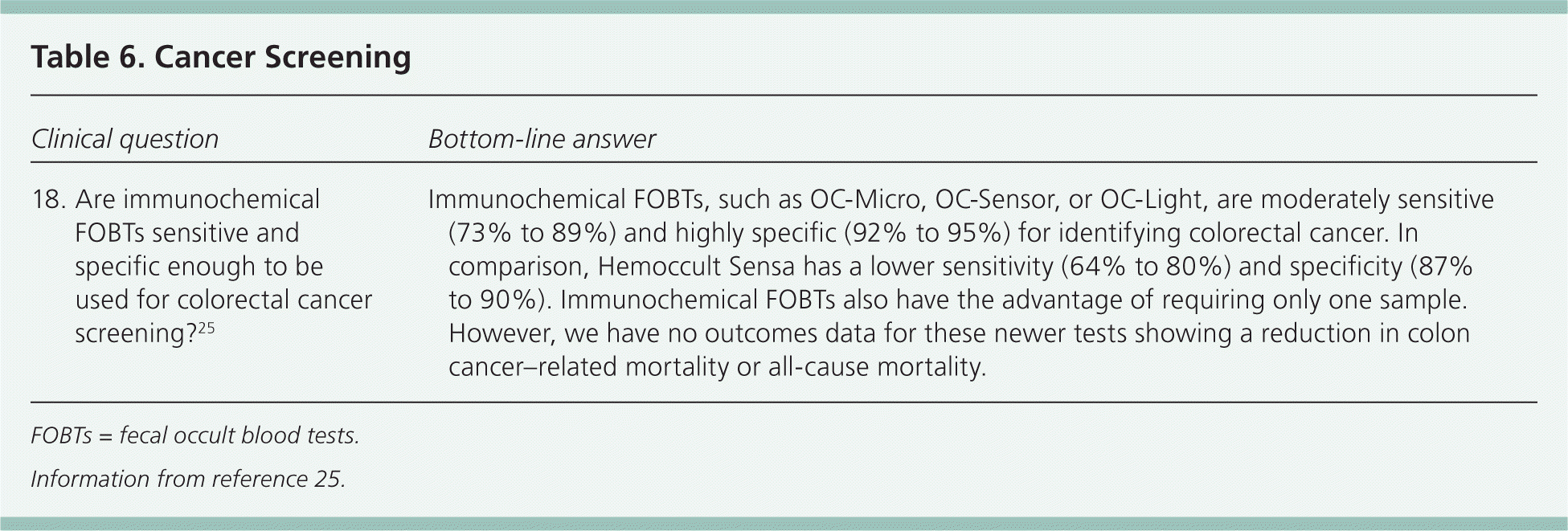
| Clinical question | Bottom-line answer |
|---|---|
| 18. Are immunochemical FOBTs sensitive and specific enough to be used for colorectal cancer screening?25 | Immunochemical FOBTs, such as OC-Micro, OC-Sensor, or OC-Light, are moderately sensitive (73% to 89%) and highly specific (92% to 95%) for identifying colorectal cancer. In comparison, Hemoccult Sensa has a lower sensitivity (64% to 80%) and specificity (87% to 90%). Immunochemical FOBTs also have the advantage of requiring only one sample. However, we have no outcomes data for these newer tests showing a reduction in colon cancer–related mortality or all-cause mortality. |
Study 18 is a systematic review of a new class of fecal occult blood tests to detect colorectal cancer (Table 6).25 The authors found that fecal immunochemical tests are much more sensitive and specific than older guaiac-based tests, and require only a single sample. Family physicians should check which they are using in their practice, and strongly consider updating to the newer immunochemical tests.25
Miscellaneous
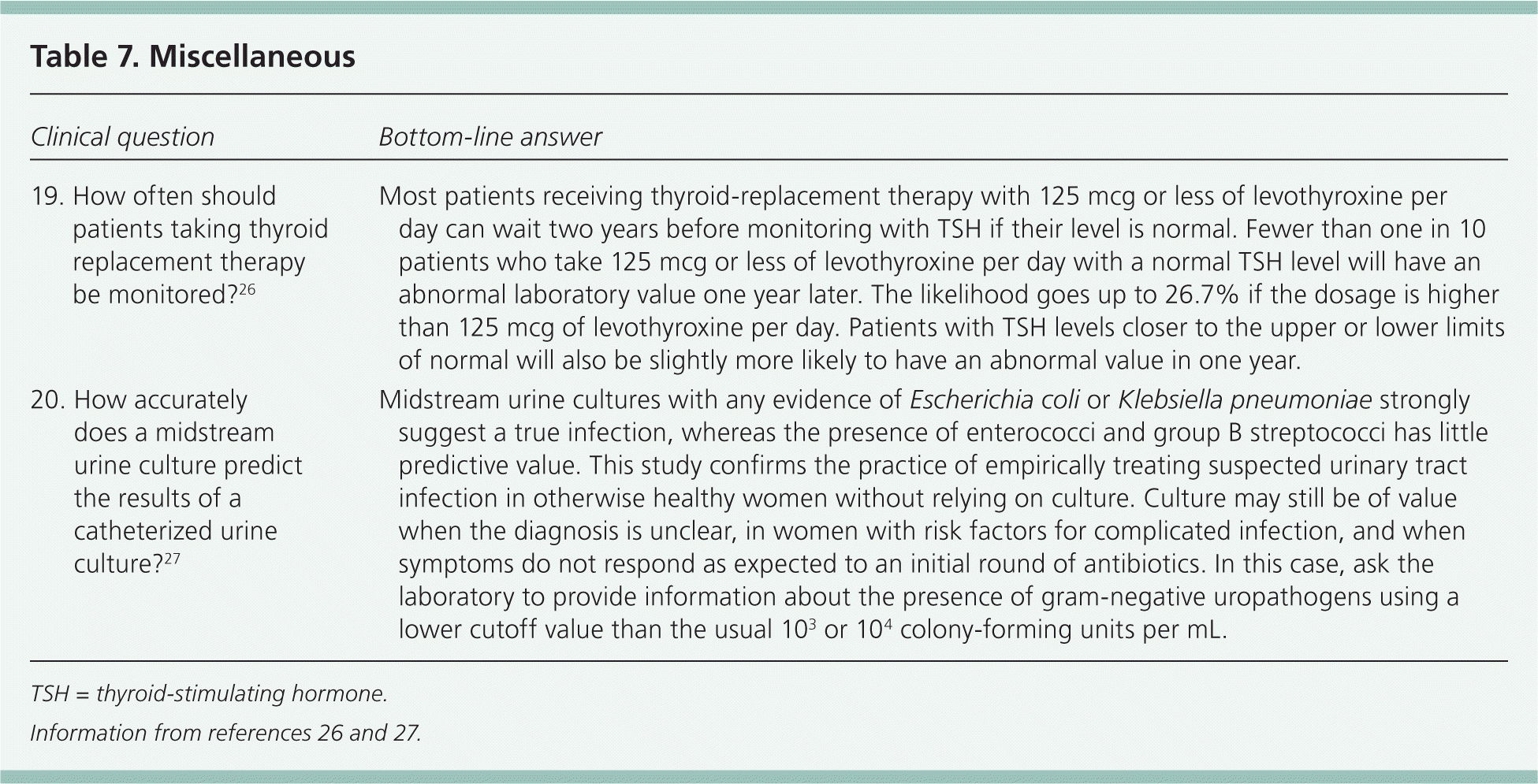
| Clinical question | Bottom-line answer |
|---|---|
| 19. How often should patients taking thyroid replacement therapy be monitored?26 | Most patients receiving thyroid-replacement therapy with 125 mcg or less of levothyroxine per day can wait two years before monitoring with TSH if their level is normal. Fewer than one in 10 patients who take 125 mcg or less of levothyroxine per day with a normal TSH level will have an abnormal laboratory value one year later. The likelihood goes up to 26.7% if the dosage is higher than 125 mcg of levothyroxine per day. Patients with TSH levels closer to the upper or lower limits of normal will also be slightly more likely to have an abnormal value in one year. |
| 20. How accurately does a midstream urine culture predict the results of a catheterized urine culture?27 | Midstream urine cultures with any evidence of Escherichia coli or Klebsiella pneumoniae strongly suggest a true infection, whereas the presence of enterococci and group B streptococci has little predictive value. This study confirms the practice of empirically treating suspected urinary tract infection in otherwise healthy women without relying on culture. Culture may still be of value when the diagnosis is unclear, in women with risk factors for complicated infection, and when symptoms do not respond as expected to an initial round of antibiotics. In this case, ask the laboratory to provide information about the presence of gram-negative uropathogens using a lower cutoff value than the usual 103 or 104 colony-forming units per mL. |
Study 19 (Table 726,27 ) asks a very practical question: how often do you have to check the thyroid-stimulating hormone level in a patient with hypothyroidism? We often use one year as a convenient interval, but does astronomy dictate biology? The study followed 715 patients, and found that of those taking 125 mcg or less of levothyroxine per day, less than 10% had an abnormal value one year later. It appears that patients taking a dosage in this range can safely stretch out the interval between checks to two years.26 Finally, study 20 compared midstream urine cultures with cultures from catheterized specimens in the same women. The results confirmed that culture is unnecessary for most women with urinary tract infection, and that when we do order a midstream urine culture, the presence of Escherichia coli or Klebsiella pneumoniae suggests a true infection, whereas gram-positive pathogens do not.27 The authors suggest using a cutoff of 102 colony-forming units per mL rather than the usual 103 or 104 colony-forming units per mL used by most laboratories.
Final Comments
These top-20 POEMs are based on an original research study or systematic review. Two POEMs that summarized practice guidelines and one POEM that included a discussion of overdiagnosis were also highly rated by Canadian physicians. The first POEM summarized the key messages of the new U.S. hypertension guidelines: the blood pressure goal is 140/90 mm Hg for most patients; lower targets are no longer recommended for patients with diabetes; and the preferred medications for white patients are a thiazide, calcium channel blocker, ACE inhibitor, or ARB, and for black patients, a thiazide or a calcium channel blocker.28 The second POEM summarized a new guideline from the American College of Physicians that recommends against routine use of screening pelvic examinations in asymptomatic nonpregnant women. This is consistent with a recent systematic review of the pelvic examination as a screening test for ovarian cancer, which found that it has a very poor positive predictive value (less than 3%).29,30 The third POEM addressed the potential harms of screening mammography, including overdiagnosis. This is a new concept to many physicians, and it means that some breast cancers (about 20%, by the best estimates) would never have come to a woman's attention during her lifetime if not for screening mammography. The challenge is that we do not know how to distinguish overdiagnosed cancers from those that are clinically important, which is an area of ongoing research.31
editor's note: This article was cowritten by Dr. Mark Ebell, who is a member of the U.S. Preventive Services Task Force (USPSTF). This article does not necessarily represent the views and policies of the USPSTF. Dr. Ebell is also deputy editor for American Family Physician (AFP) and cofounder and editor-in-chief of Essential Evidence Plus, published by Wiley-Blackwell, Inc. The POEMs described in this article stem from work that Dr. Ebell and his colleagues have been doing for the past two decades. Medical journals occasionally publish an article summarizing the best studies in a certain field from the previous year; however, those articles are limited by being one person's idiosyncratic collection of a handful of studies. In contrast, this article by Drs. Ebell and Roland Grad is validated in two ways: (1) the source material (POEMs) was derived from a systematic review of thousands of articles using a rigorous criterion-based process, and (2) these “best of the best” summaries were rated by thousands of Canadian primary care physicians for relevance and benefits to practice.
Because of Dr. Ebell's dual roles and ties to Essential Evidence Plus, the concept for this article was independently reviewed and approved by a group of AFP's medical editors. In addition, the article underwent peer review and editing by four of AFP's medical editors. Dr. Ebell was not involved in the editorial decision-making process.—Jay Siwek, MD, Editor, American Family Physician
The authors thank Wiley-Blackwell, Inc., for giving permission to excerpt the POEMs; Drs. Allen Shaughnessy, Henry Barry, David Slawson, Nita Shrukani, and Linda French for their work in selecting and writing the original POEMs; the academic family medicine fellows and faculty of the University of Missouri, Columbia, for their work as peer reviewers; Pierre Pluye, PhD, for his work in codeveloping the Information Assessment Method; and Maria Vlasak for her assistance with copyediting the POEMs for the past 21 years.
